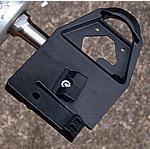
Recently on Cyclingnews.com |
Reviews
Keywin CRM titanium pedals
By John Stevenson
 |
The triumvirate of Look, Time and Shimano dominates the pedal market, but there are plenty of alternatives out there if you're prepared to look beyond the Big Three. Keywin, from New Zealand, is one of the many smaller companies producing pedals that have unusual features that set them apart from the mainstream.
In Keywin's case the main claim to fame of its CRM pedal is the weight: at under 200g per pair for titanium-axled version, these are seriously feathery pedals, though they do gain some mass back when you take into account the cleats and the metalware necessary to fix them to a shoe. To be fair to Keywin, the same's true of other pedals too; pedal weights should really be listed as pedal plus cleat weights.
Low mass isn't the only feature of the CRMs though. The TLA stands for 'Controlled Radial Movement'. That means two things: the six degree's of free rotation of the shoe on the pedal in centered around the cleat, and the resistance to that motion can be adjusted.
It's a source of debate whether pedals should allow rotation like this or pivot around the front of the cleat, and it's probably one of those things that comes down to personal taste. The same is true of resistance to rotational motion, but if you find totally free float makes you feel like you're walking on ice, then the Keywin's adjustability is welcome.
Clipping in is a very standard matter of catching the front of the pedal with the front of the cleat and pressing down, though you then have to twist your foot inwards to finish the engagement. This two-part action takes a little getting used to after 'stomp-and-go' pedals, but it shortly becomes second nature.
Release was completely reliable: twist out and the pedals let go. No complaints.
The large pedal platform and associated large cleat makes for a broad, comfortable platform. With super-stiff carbon-soled pedals now relatively affordable, this is less of an issue than it used to be, but if you have a favourite pair of old shoes that aren't stupendously rigid, the Keywins are a good match. They need a three-bolt Look-pattern mounting.
As shipped, our CRM sample had quite stiff bearing seals. This wasn't enough to make any detectable difference to the effort needed to pedal, but it did cause problems clipping in. The fiber-reinforced nylon pedal body is so light that any seal friction stops it from rotating on the axle if there's no foot there to push it round. It therefore stays wherever you leave it when you unclip, and you can find yourself trying to engage the back of the pedal body. For racing this isn't an issue – how often do you unclip and clip in during a race? – but if you ride bike in traffic, as I do, you might want to choose a pedal with easier entry.
If weight is your main criterion for choosing components, then the Keywin CRM's definitely deserve your attention, and being able to adjust the float resistance without affecting the exit force is a definite plus. I'm a fanatic for versatility, though, and the tricky entry loses them a point.
Weight: 196g/pair (bare pedals – cleats: 74g)
Price guide: $170 (USA)
Pro: Very light; consistent exit; adjustable resistance
Con: Slightly tricky entry
More information: Keywin's
website
Cyclingnews Rating: ![]()
What do you think of the Keywin CRM Titanium? Let us know

